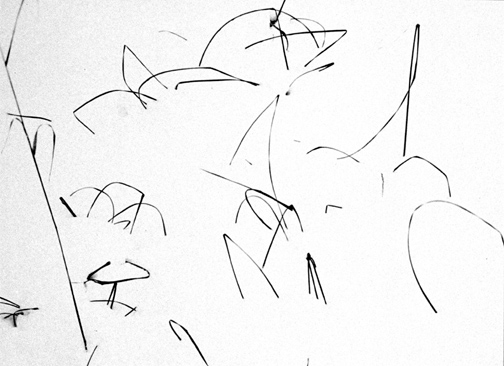Schwarz
View current page
...more recent posts
biennale of architecture venice 2004 // german pavilion
project 90 // 09.09.2004 // residential building with studio gleissenberg
"In Gleissenberg, a village in the Bavarian Forest with a population of 1000, a house with a transparent plastic envelope comes as a surprise in the new development area. The simpe shape of this low-cost project makes reference to traditional methods of housebuilding in the countryside but re-interprets these methods by using new materials. In spite of the tight budget, the Munich architect Florian Nagler designed a large, light-filled house with a studio for the clients in the form of a prefabricated wooden building, enclosed in high-quality polycarbonate grouser plates."
look through any window
teardrop park 1.9 acre downtown greenspace
"Castaing is widely described as legendary and a cult figure, so it might come as a surprise that she created rave-review rooms with undistinguished objects, often of dodgy condition."
"Amassed over 30 years, the collection was stored first in a barn in Hertfordshire, England, and later in warehouses in London and Geneva. It is uncatalogued in any computer file and the only record of its holdings have until now been in Mr. Danowski's mind. He said that he could envision the library, virtually volume by volume, though he had never seen it all assembled. It was shipped to Atlanta in about 1,500 cardboard boxes and tea crates that filled two 40-foot-long and two 20-foot-long cargo containers."
"Record companies are taking such a large cut from tracks sold online that many of the burgeoning online music stores will go out of business, experts warned yesterday."
"There's a chain store on Queen Street with signs in the windows advertising "brand-free" clothing. Welcome to the brand new era of the brand-free brand.
It sounds confusing — oxymoronic even — but we have to admit it seems a novel marketing approach.
Well, it might not be so brand new, after all. As philosphy teachers Joseph Heath and Andrew Potter argue in The Rebel Sell: Why The Culture Can't Be Jammed, this trend has a long, rich heritage, one that can be traced back to the first days of '60s counterculture."
via fatherflot
the fugs live at the knit oct seven
carving a garden into the woods
Ground Zero in 288 Pages
An annotated look at Libeskind’s opinionated new memoir.
By Boris Kachka ny metro
Ground-zero architect Daniel Libeskind, subject of blanket local coverage, hopes to fill in the remaining gaps in his new memoir, Breaking Ground: Adventures in Life and Architecture. One of the biggest adventures, of course, has been his very public battle with architect David Childs, chosen by lease-holder Larry Silverstein to execute Libeskind’s master plan.
An index
Childs, David
Compared to the Jabberwocky (243)
Gives Libeskind “a warm hug” (244)
Ground-zero takeover plans compared to The Brothers Karamazov (249)
Libeskind’s “forced marriage to” (243–266)
Power-sharing arrangement compared to North–South Korea border tensions (255)
Treats wife Nina and female Libeskind CEO “like dogs,” says Libeskind lawyer Ed Hayes (255)
Storms out of a meeting (263)
Early employment
Constructs whalebone corsets for his mother, sees them as “applied Euclidean forms” (58)
Asked to perform “mindless, robotic action” as assistant for Richard Meier, quits (41)
Asked to sweep Peter Eisenman’s office, quits (42)
Eisenman, Peter
“No one has ever called him a mensch” (41)
Ground-zero developer Larry SilversteinM
Compared to Nikita Khrushchev (261)
“Not a man who cares much about how things look” (244)
Tells Libeskind, “I don’t want you touching my building” (245)
Jewish Museum in Berlin
Called an “architectural fart” by Berlin building director (134)
Opens on September 11, 2001 (13)
Philip Johnson says, “My God! It’s not possible that this building is actually going to get built, is it?” (140)
“Would not be about toilets” (6)
Johnson, Philip
Calls architecture “this queasy feeling in my stomach” (107)
“Gestured at the AT&T building and laughed—laughed at his own work!” (140)
Libeskind, Daniel
Accordion child prodigy (8–9)
Attends Cooper Union in the sixties, misses out on all the drugs (159)
Contributes a list to Rolling Stone’s “Cool” issue (156)
Labors manually at kibbutz as a child (225–226)
Late bloomer (6, 81, 98)
Lumped in with Sartre and Mao in the London Times (194)
“More cornball than cosmopolite . . . a grateful immigrant” (159)
Possibly a direct descendant of Prague’s Rabbi Loew, creator of the Golem (111)
Storms out of meetings (31, 134, 260)
Upstages a young Itzhak Perlman (9)
Upstages the New York Times’ Herbert Muschamp (31)
Work is brilliant, with human imperfections, like Mozart’s (128–130)
Libeskind, Nina
At age 20, first impression: “so beautiful she must be stupid” (105)
Single-handedly saves the Jewish Museum project (140–146)
Smooths things over with Muschamp (31)
Meier, Richard
Perry Street towers as gross violation of privacy (69–70)
Muschamp, Herbert
Comes out against Libeskind’s ground- zero proposal; Libeskind comments, “What insanity was this!” (167–172)
Has “wrapped his power around himself like a luxurious fur-lined cloak” (21)
Internal compass “swings quixotically” (22)
Keeps Libeskind waiting for an hour because he’s taking a long bath (22)
New York
A place where “nobody has said anything nasty to me” (274)
lopate with libeskind, arad and calatrava
free land homestead marquette kansas
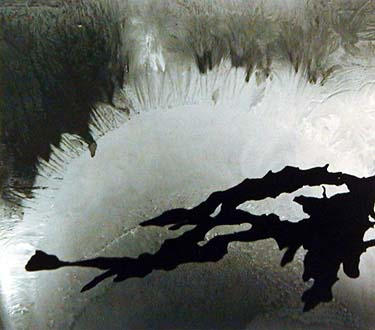
"If by chance someone is looking at some picture that seems to be a "found photograph," it makes no difference that he understand what I was trying to do, because I was not trying to do anything."
- minor white
massive change
mau q & a
at the tone
"
number stations
housing crisis / container homes
g.d. flying saucer houses
futuro
chuckhouses via energistx
the original chuckhouse
container home manual from e.bay manual dealer
shipping-container-housing
ipodlounge
fewer maine island clunker cars
florida dome home defies hurricane
Negative Lands's Mark on 2600 "Intellectual Property", Creative Commons, sampling, RIAA, and the like discussed here: (choose the Sept 22 program off the hook -"L" to download, "S" to stream.)
motorcycle diaries
comcast on demand service is great. current personal favorites are, curb your enthusiasm, sopranos and entourage. i really cant stand sex in the city but its there too w/o commercials. for some reason you can also get some ainme network shows on demand even though there is no anime network in the schedule. only down side bbca does not submit trailer park boys (plug, plug) for on demand service

pierre restani
shipping pallette shelter
I-beam design nyc

rip russ meyer
inventor of famous grunge and metal band names
greywater
duveen' art of the deal
"Ruth Franklin writes about the life and career of Elsie de Wolfe, the inventor of the profession of interior decorating, on the occasion of the rerelease of her classic book “The House in Good Taste.” This Profile of de Wolfe, from 1938, was written by Janet Flanner, who wrote The New Yorker’s Letter from Paris from 1925 to 1974."
gropius frank house pittsburgh
nyt references satanic rolling stones lyrics describing martha stuart living magazine cover
"Eight years after they acquired the island, they are constructing a house designed by the architect Frank Lloyd Wright for their island on the 683-acre lake in southern Putnam County. "This house, though, will be more than just another house," Mr. Massaro said. "It will be a work of art."
off to the class '74 scarsdale high school reunion
hermit crab housing shortage
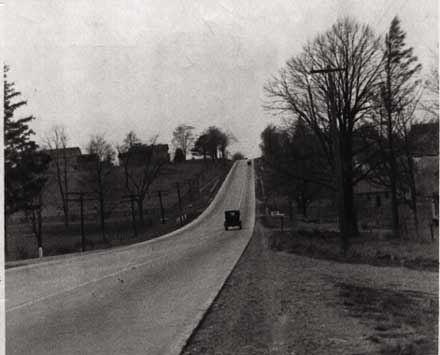
"In 1935, the collaborative satirical writers Ilya Ilf (1897-1937) and Evgeny Petrov (1903-1942) traveled to the United States from the Soviet Union on assignment as special correspondents for the newspaper Pravda. Shortly after their arrival in New York aboard the French luxury liner Normandie, they purchased a Ford automobile and embarked upon a ten-week road trip to California and back. Ilf and Petrov visited America as literary tourists, stopping at major attractions, staying in tourist motels, consulting with AAA for travel advice, and relying upon Russian-speaking tour guides to smooth their way. Like a good tourist, Ilf extensively recorded his trip with his Leica camera. Shortly after their return to the Soviet Union, the popular illustrated news magazine Ogonek— a Soviet analogue to Time magazine—published a series of illustrated articles entitled "American Photographs."1 Individual installments featured such thematic topics as the road, the small town, Native Americans, Hollywood (where they spent two weeks writing a screenplay for Lewis Milestone), advertising, African-Americans, and New York City. I first learned of Ilf's photographs from a review of "American Photographs" written by Alexander Rodchenko in 1936. I was intrigued by the images reproduced with the review—shots of rural highways and road signs that brought to mind the Depression-era images of Walker Evans. Curiously, the title of this series is identical to Evans's American Photo-graphs, a landmark book in the history of photography published by the Museum of Modern Art in 1938."
your the kookie one.
no, your the kookie one.
4,5,6,7, all good cretins go to heaven
40 ramones songs in an hour and a half
"the greatest rock and roll band ever!"
- dave the spazz
Release Date: 10/05/2004 "By 1958, Albert Ayler and his horn had made some rounds: from boy prodigy to teenage member of Little Walter's Blues Band, from 'Little Bird' of Cleveland to featured U.S. Army Band soloist. Then he resolutely set out to forget everything he ever learned about how to properly play the sax so he could channel symphonies to God out of his horn. Seeking nothing short of Truth in music, Ayler shortly became THE catalytic force in defining the sound of the tenor in Free Jazz, and was a heavy influence on John Coltrane's later work. Holy Ghost is the first comprehensive attempt to construct a monument in sound to Albert Ayler, including his never-before-heard first and last recordings, book-ending rare and unissued music from every stage of his career. 9 CDs of rare and unissued recordings, 208 page full color hardbound book, new essays by Amiri Baraka, Val Wilmer, and other Ayler scholars, 10th bonus disc with Ayler as a member of the U.S. Army Band, all housed in a lavish 9.5" square by 3" deep Spirit Box cast from a hand-carved wooden original."
tall buildings
"While it may be reasonable to assume that the items featured in a museum exhibition be small enough to fit into a room (or at least into the museum itself), or that they would actually, well, exist, such is not always the case.
This summer, for example, the Museum of Modern Art has been casting a curator's eye on skyscrapers - few of which are finished structures, and none of which would fit through the front door. In the MoMA's temporary Queen's headquarters, this dilemma was solved with the use of models. On the companion website, the solution included, but was not limited to, the 2-D world of artists' conceptions - and given the necessarily virtual nature of the artifacts in both locations, and the opportunity for leisurely at-home viewing online, MoMA: Tall Buildings may be one of those few exhibits which is actually better surveyed on the web."
This is some good Herbert gossip (note: Aric Chen, quoted below, is the gossip columnist for The Architect's Newspaper. And this lawsuit is apparently 'the straw that broke the camel's back' with Herbert and his leading role at the Times). He is so self-destructive. I actually find it sad:
"And now, a word from Off the Record [NY Observer] architecture correspondent Gabriel Sherman:
On Sept. 12, Suzanne Stephens, a special correspondent for Architectural Record, was boarding Delta Airlines Flight 145 traveling back to New York from the Venice Biennale, and found she was seated in the same middle row as 56-year-old former architecture critic of The New York Times Herbert Muschamp.
Ms. Stephens, author of the just-published Imagining Ground Zero: The Official and Unofficial Proposals for the World Trade Center Site, and Mr. Muschamp came to blows earlier this year, when Ms. Stephens tried to include in her book architects who had contributed to a special issue of The New York Times Magazine that pulled together plans for the World Trade Center site, and which Mr. Muschamp had curated. Fellow Times reporter Julie Iovine was seated one row behind.
According to Ms. Stephens, upon realizing the pending seating arrangements, Mr. Muschamp promptly turned to Ms. Stephens and declared: "Would you mind switching seats with Julie [Iovine] so I don’t have to look at your fucking face?"
To which Ms. Stephens said she retorted, "Certainly, and may you rot in hell!"
The verbal volleys drew the attention of nearby passengers, according to sources on the flight. A woman from Croatia jumped up and said, "Well, it looks like you all know each other!" Other passengers sneaked curious looks towards Mr. Muschamp and Ms. Stephens.
"Herbert was already sitting down when I got to my row, and he turned and without saying hello, that’s when it happened," Ms. Stephens told Off the Record. "He told me, ‘Do you mind switching seats with Julie, so I don’t have to look at your fucking face?’ That’s when I answered back."
Neither Mr. Muschamp nor Ms. Iovine returned calls for comment before press time.
Eventually, Ms. Stephens and Ms. Iovine swapped seats, and then Mr. Muschamp and Ms. Iovine traded seats again before take off. Once the musical chairs between the smarting journalists subsided, the parties settled in for the flight, in which architects Jessie Reiser, Nanako Umemoto, Enrique Norten, Preston Scott Cohen, MoMA curator Paola Antonelli and director Spike Lee were also on board.
Aric Chen, a contributing editor at Surface Magazine and a design writer who has penned pieces for GQ and Elle Decor, was also on the plane, seated in the aisle across from the developing fracas.
"Throughout the entire flight, Herbert had this creepy smirk on his face. He had the look of someone who was unraveling," Mr. Chen said. "It was kind of a zombie-ish, smug little smirk."
According to a source familiar with the dispute between Ms. Stephens and Mr. Muschamp, it all began in February of this year, when Mr. Muschamp learned Ms. Stephens was preparing the book. Mr. Muschamp was reportedly furious that Ms. Stephens had contacted the architects in the Times Magazine spread—many of them his personal friends—without approaching him first. This winter, the two sides ratcheted up the legal rhetoric, with Ms. Stephens’ lawyer issuing a letter threatening to sue Mr. Muschamp for tortious interference and Mr. Muschamp threatening legal action of his own. The two sides finally reached an accord this spring, but by that time, most of the architects in the Times Magazine package declined to participate in Imagining Ground Zero.
"The Times was prevented from being represented in the book by one of their employees, and the project couldn’t show all the work of something The Times had sponsored, because of the machinations of one of their employees," a source involved in the proceedings said.
"You know, it’s funny—I guess I felt I was doing the right thing all along, no matter how horrible it got," said Ms. Stephens. "I wasn’t doing something I didn’t think was right. These architects had done a lot of work, and they deserved to be in this project." Then she added: "But I’m not confused or upset. For Herbert, it’s a power thing."
—Gabriel Sherman
via (frequent contributer to this page) Selma
ten things your architect wont tell you
skinny house
haunted hillbilly
"Dan Yack and The Confessions of Dan Yack, both by Blaise
Cendrars ...small but packed with detail, and some of the best descriptive
passages regarding drunken-ness ever. Not new, but the writing is timeless.
also, Fernando Pessoa- The Book of Disquiet, set in Lisbon, reads kind of
like Joyce...praise to obscurity,failure,initelligence,difficulty and
silence."
via vz
"He hired Richard Meier as an adviser, and they selected venerable figures such as Graves, Cobb, Richard Rogers, and Philip Johnson, along with younger celebrity architects—Zaha Hadid, Steven Holl, Shigeru Ban, and Eric Owen Moss—to design houses. They also chose several architects who are less well known to the general public but have substantial reputations in the academic world—people like Stan Allen, Lindy Roy, Winy Maas, Jesse Reiser, Nanako Umemoto, and the sisters Gisue and Mojgan Hariri. This project may be the closest such architects will ever come to designing a freestanding house."
"These days, when he’s not hanging out with Brad Pitt or posing for American Express ads (give the guy a break; he deserves a little fun now and then), Frank Gehry might be practicing to sound more like, well, Frank Gehry. We hear the architect is set to make a cameo appearance, as himself, on an episode of The Simpsons this upcoming season. While Gehry’s rep could not provide specifics, we understand that, despite that institution’s interest in the location (as well as everywhere else), Gehry will not be designing a Guggenheim for Springfield."
from the architects newspaper via selma
pods, monsters, blobs, gimmicks and computer-aided design
Few architects have transform their cities so much for the better as the stonemason-turned-architect Andrea Palladio did in Venice 500 years ago. It is hard to turn one's back on this city-on-water, basking in the summer sunshine, and plunge into the largely obscurantist national pavilions and dark dockyard exhibition venues of the ninth Architecture Biennale. Not least because the theme of this year's show is metamorphosis: how contemporary architecture is bursting out of the chrysalis of rectlinear (Palladian) design into something more fluid.
small house 1 week course at shelter institute
alone in the wilderness
"In 1968, Richard Proenneke (1917–2003) chose an idyllic site at Twin Lakes in Alaska's Lake Clark National Park, cut trees, built a log cabin, and became a self-sufficient craftsman, making what was needed from materials available. He recorded his observations there for almost 30 years, until 1995. This program follows Proenneke's day-to-day explorations and the activities he carried out alone, as well as the chain of nature's events that kept him company."
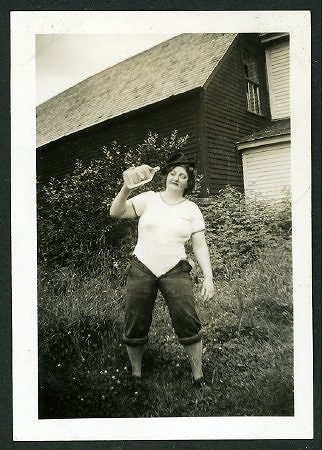
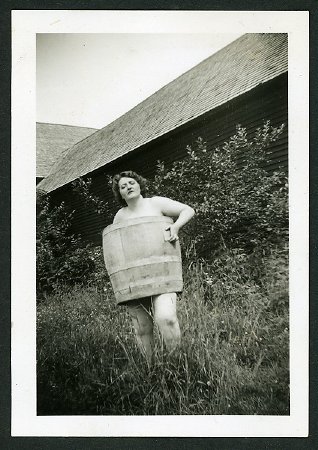
A $25 million restoration is under way at the Darwin D. Martin House, part of a red-brick Prairie-style complex that rose in 1905, a year before the Larkin office building was completed. Already workers have torn down a boxy apartment building that was shoehorned into the Martin House site in 1962 and have patched the house's masonry.

hidden looney tunes gags
"It is a nomadic project for in- and outdoors,
that’s why I had to think about a power supply
which doesn't make use of domestic electrical power.
I got the hint from a traditional japanese lamp,
which is called CHOCHIN - a portable lamp,
used with a candle in the EDO period.
in my work, the candle flame changes into a LED,
the candle wax to lithium cell and the paper shade to a
standard rubber balloon... arigato! ‘
says the japanese music artist BEKKOU aka kouichi okamoto. ’the LED does not generate heat like other lights sources,
such as incandescent lamps. that’s why LEDs do not need
air circulation. the LED gives bright illumination and the balloon
creates a diffuse light.’

warhol foundation apologist
"It was not very long ago -- three years to be precise -- that the debate over the future of Ground Zero began to coalesce around several distinct ideological camps. The discussion was dominated by two prominent architecture critics, Herbert Muschamp of The New York Times and Paul Goldberger of The New Yorker. Goldberger was consistently the wiser, steadier, more informed voice."
The Livable Masterpiece
Buying historical architectural gems, whether homes or skyscrapers, is the latest trend among those with an eye -- and the wallet -- for the fashionable, big purchase.
By Brook S. Mason, Financial Times
"So, for example, in a woodcut by Katsukawa Shunsho from about 1770, a lazy-looking man appears to be snoozing on an outdoor porch, a seemingly uninteresting subject. But this is "Poet Asleep on Balcony" and the bard lies at the compositional nexus between the strong and severe architectural structure that supports his ample body and the cascading flutter of cherry blossoms."
we're working on somthing about big tents and logcabins.
in the pipe

LE CORBUSIER
Stool, 1956/59
Oak wood
43.5 x 33 x 25.5 cm
Pavillon du Brésil, University of Paris

"the first badges were made by eric austin of kensington
CND, using white clay with the symbol painted black.
again there was a conscious symbolism.
they were distributed with a note explaining that in the
event of a nuclear war, these fired pottery badges
would be among the few human artifacts to survive
the nuclear inferno."
Jean Prouvé
Montage et démontage
Le Pavillon 6x6
via galerie patrick seguin 20c furniture and architecture
happy b day hippoblog
"Kinberg was stopped by police while demonstrating the bicycle for the television interview. His bicycle is a high-tech graffiti writer, using chalk to print anti-Bush political messages sent by people via the internet. Apparently there was a question of whether or not the sprayed messages were a defacement of property.
When Kinberg showed the police sergeant how the bicycle used a non-permanent spray chalk, the sergeant seemed to agree that it wasn't defacement, at which point Kinberg asked, "am I free to go?" After conferring about it, officers decided to call superiors, then came back moments later to place Kinberg under arrest and confiscate the bicycle.
Kinberg cooperated fully with the officers as he was being handcuffed, only asking, "can I ask what I'm being arrested for?" to which no one provided an answer. As of 11:00 PM Saturday evening, he was still in custody without being charged with anything."
greenspace

